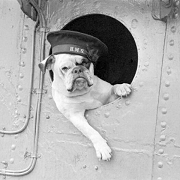|
Found out my chicano great-uncle joined less than a month after Pearl Harbor and served until Dec 45. I know he served in Korea too and ended a Mst Serg but after that the details are little hazy.
|
|
|
|

|
| # ? Apr 29, 2024 18:43 |
|
So I have a friend who's a nautical archaeologist with a focus on the Vasa, and when the whole Age of Sail gunnery discussion came up I remembered that she mentioned a lecture on the subject. Got in touch with her, and long story short, here, have a lecture on the effects of naval gunnery on a replica wooden hull and the likely effects on the crew within. There's a lot of neat footage of the effect of a 24 pound ball within the hull of a ship. Would be interested to see what the tank nerds here make of the experiment and the whole spalling situation. https://www.youtube.com/watch?v=DO71nuiN4ds&t=3709s Couple of points of note to summarize: - Accuracy on smoothbore cannons at 1000 meters require a fine degree of aiming and control that, practically speaking, didn't really exist on ships of the period (17th century) - Splinter damage was highly reliant on where the shot hit - in sum, the thicker the hull at point of impact, the larger and more deadly the splinters, while piercing through thin timbers could cause fast-moving small splinters that could be effectively deflected by wool clothing and were unlikely to pierce skin or injure someone even on exposed skin unless they hit an eye. - Conversely, hitting a heavily timbered part of the ship could create fast-moving splinters weighing a kilogram or more which will absolutely ruin your day. - There is no amount of timbering that will stop a 24-pound ball from ripping clear through your ship out both ends. - Lighter shot up to about 12 pounds or so CAN be stopped by sufficiently heavy timbering however. - Against heavy artillery a lightly built ship would actually be better than a large, heavy ship as with a light ship the ball wouldn't be causing the kind of dangerous spalling it would against a heavily timbered ship and would instead just be punching relatively small holes through (overpenetration in tank terms, right?) - Since the degree of damage caused by a ball is based entirely on where it hits, and since there's no practical way to aim for the dangerous parts of the ship, the important thing was sheer volume of fire to maximize your chances of hitting the heavily timbered sections. - The sheer variability involved explains why in some heavily fought two hour engagements you could end up with a total of two casualties between both ships, while two similar ships fighting in similar conditions could walk away with hundreds of casualties. (None of this is intended to be in support of my prior arguments by the way, I just thought this was cool and wanted to share) She also passed along a chapter from a book discussing those test results as well as the experiments they made regarding ergonomic handling of the guns and the recorded effects of sound, smoke, etc. I'll post those up once I confirm whether it's OK to pass those on or not.
|
|
|
|
Tomn posted:So I have a friend who's a nautical archaeologist with a focus on the Vasa, and when the whole Age of Sail gunnery discussion came up I remembered that she mentioned a lecture on the subject. Got in touch with her, and long story short, here, have a lecture on the effects of naval gunnery on a replica wooden hull and the likely effects on the crew within. There's a lot of neat footage of the effect of a 24 pound ball within the hull of a ship. Would be interested to see what the tank nerds here make of the experiment and the whole spalling situation. Unrelated question: Is Dr. Hocker from Philadelphia?
|
|
|
|
I've been working my way through the old military history threads again and wanted to highlight this series of posts on the British rigid airships R100 and R101 and the resulting disaster. Top notch stuff https://horseformer.blogspot.ca/2015/07/the-story-of-r100-and-r101-i-imperial.html
|
|
|
|
Scratch Monkey posted:Unrelated question: Is Dr. Hocker from Philadelphia? Sorry, I haven't the faintest idea. Why do you ask?
|
|
|
|
His accent. To people from SEPA it’s like a flashing neon sign when heard in the wild from unexpected people.
|
|
|
|
Nessus posted:This thing is cool. I found out that my great-grandpa was born in Georgia which I did not know, and also that apparently I could rent his old house if I had a mind. გამარჯობა, საქართველო თუ საქართველო?
|
|
|
|
Tomn posted:So I have a friend who's a nautical archaeologist with a focus on the Vasa, and when the whole Age of Sail gunnery discussion came up I remembered that she mentioned a lecture on the subject. Got in touch with her, and long story short, here, have a lecture on the effects of naval gunnery on a replica wooden hull and the likely effects on the crew within. There's a lot of neat footage of the effect of a 24 pound ball within the hull of a ship. Would be interested to see what the tank nerds here make of the experiment and the whole spalling situation. interesting stuff!
|
|
|
|
Just to add it for posterity. My grandfather was at a Catholic school and the nuns told him to enlist because he wasn't going to do "anything better with his life". He ended up as a Sea Bee with a bunch of older men from different backgrounds and had resolved he'd go to California after the war with some of them to start a new life. He was on guard duty one night with a guy and a Japanese suicide squad came through on Guam. He held his fellow guardsmen together, who had broken down, while holding off the Japanese until the Marines came to deal with them. He lost all of his friends on a mission where they were detonating some stuff off shore and they told him to swim to shore to let some patrolling Marines know to move back to avoid damage. He swam out to them but while he was doing it, the boat would explode with all lives lost. When he got to shore, the Marines were gone but he eventually got back to home base somehow. He'd get a service award but lose it due to running a still. After the war ended, they asked him if he wanted to watch an atomic bomb go off but he just wanted to go home. After that, he ended up working for GE and as a draftsman for the space program and worked for NASA through GE for decades. My grandfather was given his last rites three times during the war due to conditions and I'm thankful he at least got to be in my life despite those conditions. RocknRollaAyatollah fucked around with this message at 18:18 on May 30, 2021 |
|
|
|
Boat stuff is neat, matches what I'd expect.
|
|
|
|
|
What's a good book on Japanese internment in the United States during World War II? Ideally, I'd like to learn about the lead-up to it, the actual experience of those who were interned and how that varied between camps (if it meaningfully did at all), the aftermath (both short-term and more recently, like the reaction to the official apology/reparations), and whether similar things were happening in other countries at the time (or if the U.S. had done similar things in previous wars). I heard once that Canada did the same thing, which surprised me. I realized today that I know virtually nothing about the subject and that feels like a glaring hole in my knowledge of American history and that war. I'd like to fill it a little more thoroughly than just reading the Wikipedia article. Thanks to anyone who can point me in the right direction!
|
|
|
|
surf rock posted:I heard once that Canada did the same thing, which surprised me. Don't let the public image fool you, Canada was and is racist as poo poo. Culturally we mask it under feigned politeness and an enormous amount of passive-aggression. As mentioned we absolutely interned our own Japanese descended population. But also, take a guess as to when the Canadian government stopped conducting an active genocide against native peoples! Did you guess 1996? Because oh boy is it ever still a problem here. Alternatively, can you guess which province conducted a eugenics program until <checks notes> 1972??
|
|
|
|
PittTheElder posted:But also, take a guess as to when the Canadian government stopped conducting an active genocide against native peoples! Did you guess 1996? Because oh boy is it ever still a problem here. Alternatively, can you guess which province conducted a eugenics program until <checks notes> 1972?? Sweden had State Institute for Racial Biology until 1958, when they changed the name, though they stil continued the eugenics poo poo. They were really into forcibly sterilizing people they deemed inferior to the pure Nordic race as late as until 1975. They also still got the skulls of my ancestors, which they dug up to be measured in order to prove that Finns were inferior mongrels, stored in cupboards in Uppsala university's basement which they refuse to show to anyone or give back.
|
|
|
|
If it's any consolation (it isn't) Denmark is also utter poo poo about this, and was as much on board as Norway and Sweden when it came to presenting a new unified protestant people, which meant, uh, thinking saami and finns were sorcerors and burning them and their stuff if someone got sick
|
|
|
|
PittTheElder posted:Don't let the public image fool you, Canada was and is racist as poo poo. Culturally we mask it under feigned politeness and an enormous amount of passive-aggression. That's not accurate, the genocide didn't stop in 1996. Forcible sterilizations of Indigenous women officially stopped in 2018. The foster care system still takes Indigenous children away from their parents at least ten times more often than white children. Those 215 children found in the mass grave near Kamloops? Some of their murderers are still alive. I'd be surprised if anyone gets convicted. Bringing it back to milhist, what does modern battlefield archaeology look like? Some historians in Alberta are hoping this news leads to more funding to study the sites of some late 19th century battles and massacres.
|
|
|
|
IS-2 front line impressions Queue: Myths of Soviet tank building: early Great Patriotic War, Influence of the T-34 on German tank building, Medium Tank T25, Heavy Tank T26/T26E1/T26E3, Career of Harry Knox, GMC M36, Geschützwagen Tiger für 17cm K72 (Sf), Early Early Soviet tank development (MS-1, AN Teplokhod), Career of Semyon Aleksandrovich Ginzburg, AT-1, Object 140, SU-76 frontline impressions, Creation of the IS-3, IS-6, SU-5, Myths of Soviet tank building: 1943-44, IS-2 post-war modifications, Myths of Soviet tank building: end of the Great Patriotic War, Medium Tank T6, RPG-1, Lahti L-39, American tank building plans post-war, German tanks for 1946, HMC M7 Priest, GMC M12, GMC M40/M43, ISU-152, AMR 35 ZT, Soviet post-war tank building plans, T-100Y and SU-14-1, Object 430, Pz.Kpfw.35(t), T-60 tanks in combat, SU-76M modernizations, Panhard 178, 15 cm sFH 13/1 (Sf), 43M Zrínyi, Medium Tank M46, Modernization of the M48 to the M60 standard, German tank building trends at the end of WW2, Pz.Kpfw.III/IV, E-50 and E-75 development, Pre-war and early war British tank building, BT-7M/A-8 trials, Jagdtiger suspension, Light Tank T37, Light Tank T41, T-26-6 (SU-26), Voroshilovets tractor trials, Israeli armour 1948–1982, T-64's composite armour Available for request (others' articles):  Shashmurin's career T-55 underwater driving equipment Oerlikon and Solothurn anti-tank rifles Evolution of German tank observation devices
|
|
|
|
Warden posted:Sweden had State Institute for Racial Biology until 1958, when they changed the name, though they stil continued the eugenics poo poo. They were really into forcibly sterilizing people they deemed inferior to the pure Nordic race as late as until 1975. loving Swedes! Yes, definitely proud that we are not stinking colonialists with delusions of Übermensch-ity! SO PROUD!  Now, how about that railroad to the Arctic Ocean... Now, how about that railroad to the Arctic Ocean...
|
|
|
|
Nenonen posted:loving Swedes! I forgot to write "unlike us, who at least gave the skulls we stole back". But yeah, we did a lot of bad poo poo as well. Didn't we also forcibly sterilize people for being deaf too well unto 1960s or 70s? Also, the recent Yle article about how the Finns in 1920s explicitly talked about the Petsamo region as finally having gotten a colonial holding of our own was really yikes-worthy.
|
|
|
surf rock posted:What's a good book on Japanese internment in the United States during World War II? Facing the Mountain just released this month. It's more of your journalistic narrative history and I have not personally read it yet, but my dad (who is a Minidoka survivor) enjoyed it and I've liked other works by the same author. I'd encourage you to check out Densho for general incarceration information.
|
|
|
|
|
Warden posted:
Hey now, all the cool kids were doing it. And it was only decade after a war which was partially fought over colonial holdings.
|
|
|
|
https://www.youtube.com/watch?v=xI1F5SnkLBs This is a US produced instructional video on German small arms, specifically the 98K, MP40, and MGs 34 and 42. My question is: Under what circumstances would a US GI be expected to use captured German weapons? I've heard that a lot of guys preferred the MP40 because it was so good, but the US military wasn't training people with the expectation that they would pick up a lost gun and keep and use it right? I can kind of see the use case for say a captured machine gun emplacement, but was this more of a "as a last resort, here's how to use a Mauser if your M1 is broken or out of ammo" but then, why would you need to know how to field strip it? More generally, how have militaries in the modern era dealt with soldiers using non-standard or captured equipment? Anecdotally, I've heard stories of dudes in Vietnam who liked to use AKs because of the early problems with the M16, but was this something that was explicitly permitted or just ignored by field officers? (or rare and overstated?) What about now, are you allowed to use a different gun than the one you are issued?
|
|
|
|
zoux posted:https://www.youtube.com/watch?v=xI1F5SnkLBs Soldiers are going to pick up and play with captured weapons. If they're told how they function in advance, you're lessening the chance someone loses a fingat.
|
|
|
|
I thought the M1 Garand already required the regular sacrifice of fingers to operate properly
|
|
|
|
zoux posted:https://www.youtube.com/watch?v=xI1F5SnkLBs The battlefield is going to be completely awash in discarded weapons from both sides. Having a basic familiarity with them is good just because if your poo poo is broken or out of ammo you can make do with what's on hand. You don't see that too terribly much with the Americans (although a lot of soldiers who parachuted into D-Day lost their rifles due to how the drop bags were constructed and had to make do with captured German weapons for a time) but you see it a ton on the Eastern Front, for example. Beyond that, you also need to secure all that poo poo once the front line moves forward a bit. Having some basic familiarity with how to get the bolt out is useful, even if it's just policing your immediate area and tossing a pillow case full of bolts into the bottom of the nearest pond.
|
|
|
|
One of the weird things about Iraq/Afghanistan is a LOT of the folks over there were there to train host nation forces, and so had to have a working familiarity with their small arms. So, if you were on a MITT team or other kind of thing that worked with host nation troops you got a pretty beefy block of instruction on AKs and RPKs. ie, https://www.youtube.com/watch?v=qklaY1kAIWM
|
|
|
|
LRADIKAL posted:They're pretty cool, but you have to tack a bunch of electronics on to integrate them, You absolutely do not. Mechanical integrators were a fundamental part of the analog gunfire control systems of the time. The ones on the Iowas were good enough that they weren’t even touched during the refit. https://youtu.be/GZI-PydfsQs
|
|
|
|
surf rock posted:What's a good book on Japanese internment in the United States during World War II? I think Farewell to Manzanar was the book we read in school. It's kind of a memoir/reminiscences of an internee, looking back when she was an adult. It's pretty good, from what I remember. Cyrano4747 posted:The battlefield is going to be completely awash in discarded weapons from both sides. Having a basic familiarity with them is good just because if your poo poo is broken or out of ammo you can make do with what's on hand. You don't see that too terribly much with the Americans (although a lot of soldiers who parachuted into D-Day lost their rifles due to how the drop bags were constructed and had to make do with captured German weapons for a time) but you see it a ton on the Eastern Front, for example. ...how would a squad of paratroopers sans rifles hope to capture enemy weapons? Would they at least have pistols on them?
|
|
|
|
Fuschia tude posted:I think Farewell to Manzanar was the book we read in school. It's kind of a memoir/reminiscences of an internee, looking back when she was an adult. It's pretty good, from what I remember. Yeah, a lot of them had pistols and not all of them were disarmed by the jump. Lots of dudes scrambling in the dark to find each other and then basically crawl across a field to go mug some Germans for their poo poo. I think grenades were also kept separately from the drop bag for the guns. edit: plus if you're lucky you find someone else's gun and hope that it came down in one piece. It was kind of raining equipment. Here's a repro one for reenactors with a Garand in it:  The basic idea was that it's dangerous to have a rifle flopping around on you while you're jumping out of an airplane at 100+ MPH, and this protects both the weapon and you. The bags were supposed to be attached to your gear via some webbing or a rope or something and fall under you. IIRC it also helped with stability by putting the big, heavy gun basically at the bottom of a pendulum that you and your chute were part of. The problem was that on D-Day most of the aircraft dropped their paras too fast, which meant that the bags were ripped off when they jumped. Cyrano4747 fucked around with this message at 16:24 on Jun 1, 2021 |
|
|
|
Here, I found an actual pic of what I'm pretty sure are the drop bags. See the square things being carried over those guy's shoulders? Those:
|
|
|
|
This is something I learned from this thread so don't take it as me being an expert, but one of the issues with German paratroopers was that they dropped their entire kit separately and well that didn't work out so good.
|
|
|
|
zoux posted:This is something I learned from this thread so don't take it as me being an expert, but one of the issues with German paratroopers was that they dropped their entire kit separately and well that didn't work out so good. Yeah, they sent down a whole can full of guns and you had to secure it when you hit the ground. That led to problems on Crete. Here's a reenactor pulling one. It's on a glorified dolly, and iirc that got left behind on the ground. It's basically a reinforced shipping crate like all armies used for rifles at that time, just a bit smaller:  Pretty much everyone did this for the heavy weapons like mortars and LMGs, but the Germans also packed their rifles in them. edit: actual period photo of them in use, probably during a practice drop. 
|
|
|
|
One of the other problems with the drop bags was that the Americans got the idea from British paratroopers, but didn't realize they were supposed to be limited by weight - dudes would shove as much ammo and supplies as they could into the bags, and this made them so heavy that the tether would snap as soon as the chute opened.
|
|
|
|
Fish of hemp posted:Hey now, all the cool kids were doing it. And it was only decade after a war which was partially fought over colonial holdings. That's the thing, the political rhetoric of the day was all about how Finland was finally a proper "European" nation like England and France, since it finally had a colonial holding to exploit, and like the French and the Brits before them, they had a moral obligation to civilize the Sami folk living there. Which is both "holy poo poo, guys" and very stupid, since Finns and the Sami had co-existed for centuries.
|
|
|
|
If you read accounts closely it seems fairly common in any scenario where resupply is uncertain. By mid morning on D-Day the guys at Pegasus Bridge had comfortably rearmed themselves with MP40s and had organised an armoury of captured weapons to draw upon. Awful lot of accounts of people mucking about with captured light mortars because that's a very easy way for a platoon to get some extra integral firepower. Basically there's two paradoxical rules of infantry: 1. A solider will find a way to discard any kit they are supposed to carry that they don't need right now. 2. A soldier will accumulate a vast amount of kit they are not supposed to be issued with if they see any value in it at all. e: also just in general weapon familiarisation training is a good idea. There's some guys shooting over there. Do their guns sound like they're on our side or their side? Alchenar fucked around with this message at 16:50 on Jun 1, 2021 |
|
|
Fish of hemp posted:Hey now, all the cool kids were doing it. And it was only decade after a war which was partially fought over colonial holdings. We were never cool, lets be honest.
|
|
|
|
|
Fuschia tude posted:...how would a squad of paratroopers sans rifles hope to capture enemy weapons? Would they at least have pistols on them? Presumably enough would have their rifles to shoot some Germans and take their rifles to give to their friends.
|
|
|
|
Would be cool if we'd talk about the Soviet Paratroopers or the Indian ones that fought the Japanese in Burma, they seem to not get as much love. Until last year I never even knew Japan had some and used them in combat too.
|
|
|
|
|
Cyrano4747 posted:Yeah, they sent down a whole can full of guns and you had to secure it when you hit the ground. That led to problems on Crete. Still better than having to get nude to take a combat poo poo.
|
|
|
|
SeanBeansShako posted:Would be cool if we'd talk about the Soviet Paratroopers or the Indian ones that fought the Japanese in Burma, they seem to not get as much love. Soviet paratroopers were kind of the black sheep of the armed forces in the GPW and don't really have many successes to point to. They did the whole "Oorah marines" overcompensating thing after the war which surprisingly resulted in a huge jump in prestige and a whole bunch of custom hardware that they didn't get during the war. Now they have a public holiday where VDV veterans swim in fountains and are generally a public nuisance.
|
|
|
|

|
| # ? Apr 29, 2024 18:43 |
|
Also, a bit bigger than small arms, but American forces did use German equipment when they could get their hands on it. In particular, several Field Artillery battalions were set up with captured German artillery, making use of the huge excess of ammunition stocks that the Germans had left behind in France (And freeing up the strained supply of 105mm rounds). For instance, the history of the 244th Field Artillery Battalion notes the use of the 76.2cm field cannons (themselves captured and modified Soviet guns), 10.5cm light field howitzers, and 8.8cm PaK 43s. 
|
|
|




















 Yes, it's like a lava lamp.
Yes, it's like a lava lamp.























